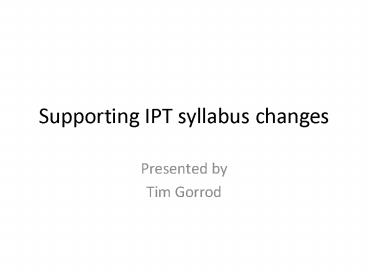Supporting IPT syllabus changes - PowerPoint PPT Presentation
1 / 38
Title:
Supporting IPT syllabus changes
Description:
Supporting IPT syllabus changes Presented by Tim Gorrod In groups, take a topic and create/collate the ideas, somehow. I might have some to put on, in case. – PowerPoint PPT presentation
Number of Views:52
Avg rating:3.0/5.0
Title: Supporting IPT syllabus changes
1
Supporting IPT syllabus changes
- Presented by
- Tim Gorrod
2
Introduction
- Name
- Where youre from
- Something you would change about your job if you
could, apart from more money/less work - Something you love about your job, apart from the
holidays
3
Why was the syllabus amended?
- There was a strong feeling that
- there was too much content, especially in the
preliminary course (also removed to avoid
duplication of concepts in HSC?) - Learn abouts/Learn tos -clarify definition of
terms and concepts and remove ambuguities - there was a need to update because of the
rapidity of change in hardware, software and the
way it is used - (Need slide Syll.P.9 Course Structure)?
4
Why was the syllabus amended?
2003
2004
2005
2006
2007
5
Where can I find resources?
- On the Board of Studies web site
- annotated syllabus
- course specification
- support document
- past exams and notes from the marking centre
- summary of changes
6
Where can I find resources?
- Join CSTA
- Go to the meetings if possible
- On line, youll find
- Preliminary sample program (Steve Madsen)
- Quality teaching tools
- Programming tools
- Sample scope and sequence
7
Whats new?
- How extensive are the changes?
- What is the general nature of the changes?
- Why is it smaller?
8
Whats new?
Changes to the preamble reflect a desire to
strengthen the requirements relating to project
work. Other changes reflect structural changes in
the course. More time has been allowed for
students to complete Tools for Information
Processes. The topics Planning, Designing and
Implementation and Personal and Group Systems
and Projects have been replaced with one topic
called Developing Information Systems. This
has been done to remove duplicated and irrelevant
content and concepts, and to provide more time to
integrate content into project work. In the HSC
course, some topic headings and subheadings have
been renamed to remove ambiguities that existed
in the original syllabus.
9
Whats new?
10
A request
the post-it notes are for
11
Whats not?
- The syllabuss orientation around how information
systems work and how they are developed - Students are expected to be competent, confident,
ethical users of IT - The project-based nature of the subject
- Much of the content, including IPT specific
jargon
12
Timing
13
Outcomes
14
Content
15
HSC 2003
Blurb goes here insert your own scenario
16
The new preliminary topicDeveloping information
systems
- Some content removed because its treated in
depth in the HSC course - Systems created by individuals and groups, or for
individuals and groups now in this topic
17
A request
- The post-it pads
- are for
dont forget
18
HSC course
- The project topic
19
HSC course
- Information systems and Databases
- Relationships now specified
- Data dictionary changed
20
HSC course
- Communication systems
21
HSC course
- Communication systems
- New hardware included
- New issues included
22
Optional slide
- Depending on where you look,
- On line transaction processing
- This refers to optimising databases to improve
online performance.
According to http//www.databasejournal.com, this
optimising consists of organising the data into
layers.
- Business logic layer rules and procedures,
optimised so that frequent requests are handled
fast
- Data layer all data needed to process
transactions
- Presentation layer the only thing that happens
at the clients end
23
Optional slide
- On line analytical processing
- OLAP speeds up the process of querying relational
databases. In the past, this has been a slow
process because properly normalised databases
have data stored in discrete tables. It does this
by pre-building sets of data based on a snapshot
of the real database. File size blows out
enormously because the data is no longer
normalised, but query speed is much higher. - It comes in three delicious flavours
- Molap
- Rolap
- Holap
- More information available at
- http//www.ebroadcast.com.au/lookup/encyclopedia/o
l/OLAP.html - http//office.microsoft.com/en-au/excel/HP10177437
1033.aspx
24
- On line analytical processing
- Drilling down refers to taking a generalised set
of results and looking more deeply at a part of
those results. For example, The rainfall in May
was high. Did it rain all month or come in
bursts?. Drilling down further could look at an
hour by hour or minute by minute analysis of the
rainfall.
- There is a nice demonstration at
- http//www.quietlyscheming.com/blog/charts/chart-d
rilldown-animations/
25
- Decision support systems
- New things here include Group decision support
systems, geographic information systems and
management information systems
26
Multimedia
- Nearly all the changes have occurred in the
course Specifications document.
27
Session 1b
- Put post-its on the syllabus extracts
28
Tools
is
will
wont
29
(No Transcript)
30
(No Transcript)
31
(No Transcript)
32
Your turn
33
Yes!
- Morning tea
34
A markers perspective
- Whats important and what works
35
Activity
- Use a quality analysis tool to check an
assessment task.
36
Activity
- Consider question 21 from the 2007 HSC IPT exam
paper - Use the marking guidelines for part c) to mark
the sample responses.
37
A
B
C
E
D
F
38
Projects
- Whats important and what works

